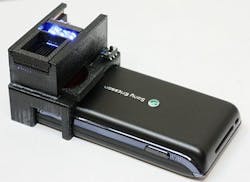Cell phone-based fluorescent imaging sensor detects E. coli
Researchers from the UCLA Henry Samueli School of Engineering and Applied Science (Los Angeles, CA) have developed a cell phone-based fluorescent imaging and sensing platform that can detect E. coli in food and water. Using a lightweight, small attachment to an existing cell-phone camera, they paired antibody functionalized glass capillaries with quantum dots as signal reporters to detect E. coli particles in liquid samples.
Using battery-powered, low-cost light-emitting diodes (LEDs), the researchers could excite/pump labeled E. coli particles captured on the capillary surface. There, emissions from the quantum dots could be imaged with the cell-phone camera using an additional lens inserted between the capillary and the cell phone.
The cell-phone attachment acts as a fluorescent microscope, quantifying the emitted light from each capillary after the specific capture of E. coli particles within a sample. By quantifying the fluorescent light emission from each tube, the researchers could determine the concentration of E. coli in the sample.
The work is promising for screening both water and food samples in the field, and at low cost.
The work is published in The Royal Society of Chemistry; for more information, please visit http://pubs.rsc.org/en/content/articlelanding/2012/an/c2an35071h.
-----
Follow us on Twitter, 'like' us on Facebook, and join our group on LinkedIn
Follow OptoIQ on your iPhone; download the free app here.
Subscribe now to BioOptics World magazine; it's free!

